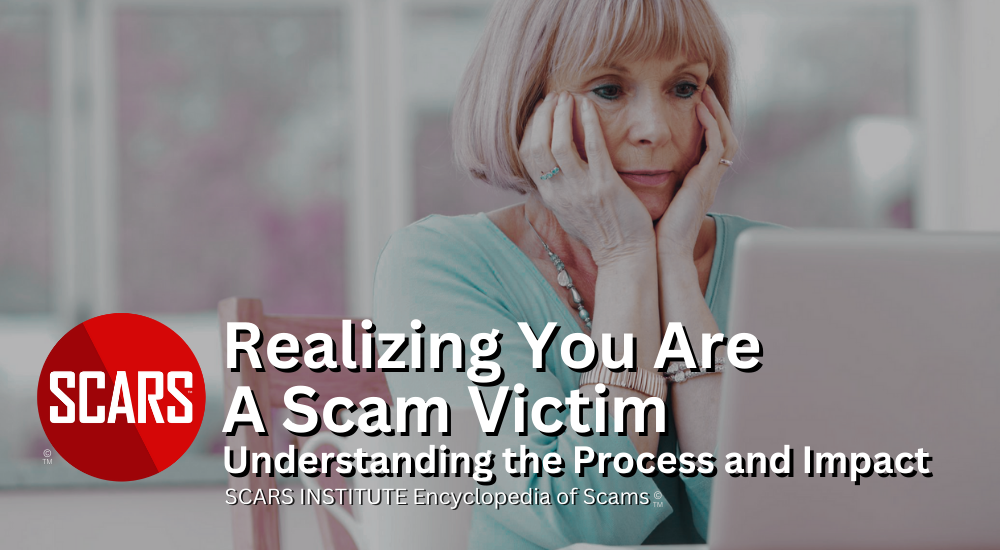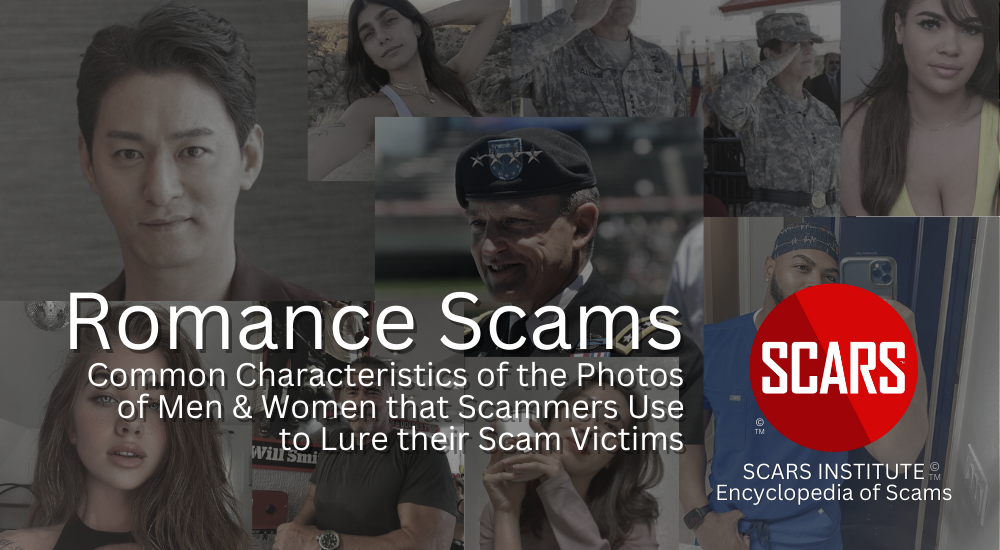Romance Scams – Common Characteristics of the Photos of Men & Women that Scammers Use to Lure their Scam Victims – 2024
Understanding some of the Psychology Behind the Scammer’s Choices in Selecting their Stolen Photos
Psychology of Scams – A SCARS Institute Insight
Author:
• Tim McGuinness, Ph.D., DFin, MCPO, MAnth – Anthropologist, Scientist, Director of the Society of Citizens Against Relationship Scams Inc.
Article Abstract
Psychological or emotional numbness in traumatized scam victims serves as both a defense mechanism and a coping mechanism. As a defense mechanism, numbness helps protect the individual from overwhelming emotional pain by detaching them from their emotions, providing immediate relief from the intense distress associated with the trauma.
This temporary emotional shutdown can help victims function in the short term, allowing them to handle necessary tasks without being consumed by their feelings. However, as a coping mechanism, prolonged numbness can hinder long-term recovery. By suppressing emotions such as anger, sadness, and betrayal, victims may avoid fully processing their trauma, which can lead to chronic issues like depression, anxiety, and PTSD.
Over time, emotional numbness can lead to a sense of disconnection from life and relationships, isolating victims and making it harder for them to heal. Recognizing and addressing this numbness through therapeutic interventions is crucial for scam victims to begin processing their trauma and reclaiming their emotional well-being.

Common Characteristics of the Photos that Scammers Use to Lure Women and Men into Romance Scams, and the Psychological Mechanisms at Work!
Why Do Scammers Steal Photos?
Scammers steal photos of real people to perpetrate their romance and relationship scams because these images lend credibility and authenticity to their fake identities. By using photos of attractive, seemingly trustworthy individuals, scammers can more easily build a connection with their targets. These photos often depict people in professional or social settings, enhancing the illusion that the scammer is a genuine, relatable person. The visual appeal of these images helps to establish an emotional bond, which is crucial in manipulating the victim’s trust and lowering their defenses.
The use of stolen photos allows scammers to create a convincing backstory and sustain the deception over a longer period. Victims are less likely to question the authenticity of someone who appears to be a real person with a full life, as depicted in the photos. This tactic also makes it harder for victims to recognize inconsistencies in the scammer’s story, as they are more focused on the visual evidence presented to them. The stolen images become a powerful tool in the scammer’s arsenal, making it easier to manipulate emotions and ultimately exploit the victim financially and emotionally.
How Many Stollen Photos Are Used by Scammers?
Scammer’s Stolen Photos
Scammers Use Photos of Men to Lure Women (or Other Men)
When scammers use photos of men to lure female victims, especially in romance scams, they often select images that are crafted to appeal to the specific emotional and psychological needs of the target audience. Here’s an analysis of the common characteristics seen in these photos:
1. Attractive and Charming Appearance
-
- Physical Attractiveness: The men in these photos are often conventionally attractive, with strong jawlines, fit physiques, and well-groomed appearances. The aim is to create an initial visual appeal that grabs attention.
- Charming Smile: Many of the photos feature men with warm, inviting smiles designed to create a sense of approachability and kindness.
2. Successful and Affluent Lifestyle
-
- Professional Attire: Similar to the photos used to lure male victims, men targeting female victims are often shown in professional or military attire. This could include business suits, lab coats, military uniforms, or even casual but expensive-looking clothing that suggests success and stability.
- Luxurious Settings: The backgrounds in these photos might include high-end homes, offices, exotic locations, or expensive cars, all meant to convey wealth, success, and an ability to provide.
3. Trustworthiness and Reliability
-
- Family-Oriented Imagery: Some photos might depict men with children, pets, or in family settings to evoke a sense of responsibility, care, and trustworthiness.
- Military or Humanitarian Work: Photos of men in military uniforms or involved in humanitarian activities are common, as they play on the perception of integrity, honor, and dedication.
4. Romantic and Sensitive Image
-
- Casual and Relaxed Poses: Photos often depict men in relaxed settings, such as at the beach, enjoying a sunset, or reading a book, to project a romantic, sensitive, and caring personality.
- Engagement in Leisure Activities: Images might show men engaged in hobbies like sailing, hiking, or playing music, suggesting they are well-rounded, cultured, and capable of sharing meaningful experiences.
5. Vague or Generalized Appeal
-
- Lack of Specific Details: The photos are often generic enough to appeal to a broad range of women. They rarely include specific or identifiable details that might allow someone to easily verify the identity of the person in the photo.
- Photoshopped or Edited Images: Some of the images might be edited to enhance attractiveness or adjust backgrounds to create a certain desired image.
6. Cultural Sensitivity
-
- Diverse Ethnic Representation: Scammers often select images that can cater to the cultural or ethnic preferences of the target audience. For example, they may use photos of men from the same ethnic background as the victim or someone they might find relatable or trustworthy.
Scammers Use Photos of Women to Lure Men (or Other Women)
When scammers use photos of women to lure male victims, they often select images that share several common characteristics. These images are carefully chosen to appeal to potential male victims and to create a persona that seems both desirable and trustworthy. Here are some typical features of the women’s photos used in such scams:
1. Attractive and Glamorous Appearance:
-
- Physical Attractiveness: The women in these photos are often very attractive, with features that are widely considered appealing, such as clear skin, symmetrical faces, and well-groomed hair. The goal is to captivate the male target’s attention immediately.
- Glamorous Presentation: The photos often depict women who appear to be stylishly dressed, wearing makeup, and posing in a way that accentuates their physical attributes. This can make the persona appear more sophisticated and desirable.
2. Professional or High-Quality Photos:
-
- High Resolution: The images tend to be high-resolution and professionally taken. These might be sourced from modeling portfolios, social media profiles of real individuals, or stock photo websites.
- Well-Lit and Polished: The photos are often well-lit and polished, which gives them an air of professionalism and makes the persona seem more legitimate.
3. Suggestive or Provocative Posing:
-
- Seductive Poses: Many of these photos feature women in poses that are meant to be seductive or alluring. This is done to create a sense of sexual attraction, which can be a powerful tool for manipulation in scams, especially romance scams.
- Revealing Clothing: The women might be shown wearing revealing or form-fitting clothing that highlights their figures. This can further draw in male victims who might be looking for romance or companionship.
4. Diverse Locations and Settings:
-
- Exotic or Luxurious Locations: Like with male photos, scammers may use images that show women in exotic or luxurious locations. This can imply that the woman has a desirable lifestyle, which can be appealing to potential victims.
- Casual and Relatable Settings: Alternatively, some photos may depict women in more casual, relatable settings, such as at home, in nature, or doing everyday activities. This can create a sense of normalcy and approachability.
5. Youthful Appearance:
-
- Young and Vibrant: The women in these photos are often young, or at least youthful in appearance. This youthfulness is intended to appeal to men who may be seeking a partner who is perceived as energetic, fun, and full of life.
6. Innocent or Vulnerable Expression:
-
- Soft and Innocent Expressions: Many scammers use photos where the women have soft, innocent expressions, which can evoke feelings of protectiveness and care in the male target. This can make the victim more inclined to offer help or feel emotionally invested in the persona.
7. Social Media Aesthetic:
-
- Selfies and Casual Photos: Scammers might use selfies or photos that look like they were taken casually for social media. These types of images can make the persona seem more authentic and relatable, increasing the chances that the victim will engage.
By carefully selecting images that meet these criteria, scammers aim to create a fictional persona that is highly appealing to male victims, thereby increasing the likelihood that the victim will be manipulated into providing money, personal information, or other forms of support. These images play a critical role in establishing trust and forming an emotional connection, which are key elements in the success of such scams.
Cognitive Biases Play an Important Role
When scammers use photos to lure their victims, cognitive biases play a significant role in lowering the victim’s guard. These biases can cause victims to overlook red flags and make them more susceptible to manipulation.
Here’s a detailed explanation of how various cognitive biases, including some additional ones, come into play:
Halo Effect
What It Is: The Halo Effect is a cognitive bias where the perception of one positive trait (like physical attractiveness) influences the perception of other traits (such as trustworthiness or intelligence).
Role in Scams: When a victim sees a photo of an attractive person, they may subconsciously assume that the person is also kind, trustworthy, and reliable. This bias can cause the victim to overlook inconsistencies or suspicious behavior in the scammer’s communication because they are influenced by the positive first impression created by the photo.
Framing Effect
What It Is: The Framing Effect occurs when the way information is presented influences how it is perceived. The same piece of information can be seen differently depending on the context or “frame” in which it is delivered.
Role in Scams: Scammers carefully choose photos that fit a specific narrative or frame. For example, a man in a military uniform might be framed as a hero or a dedicated professional, while a woman in a caring pose with children might be framed as nurturing and trustworthy. This framing influences the victim’s perception of the scammer, making them more likely to accept the scammer’s story or request without questioning it.
Hollywood Effect
What It Is: The Hollywood Effect refers to the influence of media portrayals on our expectations and beliefs. It shapes how people think about relationships, appearances, and behaviors based on what they see in movies and TV shows.
Role in Scams: Scammers often use photos that fit the idealized images promoted by Hollywood. For example, a handsome man in a military uniform or a beautiful woman in a glamorous setting might trigger associations with movie characters who are brave, noble, or pure-hearted. Victims, influenced by the Hollywood Effect, may project these fictional characteristics onto the person in the photo, making them more vulnerable to the scam.
Confirmation Bias
What It Is: Confirmation Bias is the tendency to search for, interpret, and remember information in a way that confirms one’s pre-existing beliefs or expectations.
Role in Scams: If a victim is already inclined to believe in the possibility of a romantic relationship with an attractive person they met online, they may interpret the scammer’s photos and messages in a way that supports this belief. They may overlook or rationalize any inconsistencies or red flags because they want to believe that the relationship is real.
Sunk Cost Fallacy
What It Is: The Sunk Cost Fallacy is the tendency to continue investing in something (time, money, effort) because of the resources already invested, rather than evaluating the situation based on its current merits.
Role in Scams: After exchanging messages and forming an emotional connection with the person in the photos, victims might feel compelled to continue the relationship even when doubts arise. The time and emotional energy already invested make it difficult for them to walk away, even if they sense something is wrong.
Social Proof
What It Is: Social Proof is the tendency to follow the actions or opinions of others, especially when uncertain about a situation.
Role in Scams: Scammers often use photos that depict the person in social settings or professional environments that imply legitimacy. For example, a man in a military uniform surrounded by other soldiers, or a woman with her “family” in a happy setting, can create an impression of normalcy and trustworthiness. The victim, influenced by the apparent social proof in the photos, might be less likely to question the authenticity of the person.
Affect Heuristic
What It Is: The Affect Heuristic is a mental shortcut where people rely on their emotions to make decisions quickly.
Role in Scams: Scammers know that visually appealing photos can evoke strong positive emotions. A charming smile or a friendly face can create a sense of comfort and safety. Victims may make quick judgments based on these emotional reactions, ignoring rational analysis or warning signs because they “feel” like the person in the photo is trustworthy.
Magical Thinking
What It Is: Magical Thinking is the belief that one’s thoughts, wishes, or actions can influence the outcome of events, often in an unrealistic manner.
Role in Scams: Scam victims might believe that their connection with the person in the photo is “meant to be” or that fate brought them together, even if the situation seems improbable. This belief can make them more likely to ignore red flags and continue the relationship, thinking that their positive feelings will lead to a happy outcome.
Mere Exposure Effect
What It Is: The Mere Exposure Effect is the tendency to develop a preference for things simply because they are familiar.
Role in Scams: Scammers often send multiple photos to create a sense of familiarity. The more a victim sees the same face, the more they might feel comfortable with and trust that person, even if there is little real interaction or evidence to support that trust.
Optimism Bias
What It Is: Optimism Bias is the tendency to believe that we are less likely to experience negative events and more likely to experience positive outcomes.
Role in Scams: Scam victims may believe that despite the risks or the oddities in the scammer’s communication, their situation will turn out well. This bias can make them underestimate the likelihood of being scammed and ignore warning signs.
Reciprocity Bias
What It Is: Reciprocity Bias is the expectation that when someone does something for us, we should return the favor.
Role in Scams: If a scammer sends gifts, compliments, or emotional support through their messages, the victim might feel obligated to reciprocate, whether that means sending money, personal information, or continuing the relationship despite doubts.
Representativeness Heuristic
What It Is: The Representativeness Heuristic is the tendency to judge the probability of an event by how much it resembles what we consider to be typical.
Role in Scams: If a scammer’s photo and behavior fit the victim’s preconceived notions of what a romantic partner or friend should look like and act like, the victim may believe the relationship is genuine. They might ignore discrepancies because the scammer fits a “type” that they trust.
Scarcity Heuristic
What It Is: The Scarcity Heuristic is the perception that things that are scarce are more valuable.
Role in Scams: Scammers might present themselves as a rare opportunity—someone who is highly sought after but interested in the victim. The belief that this relationship is special and not easily found can make the victim more likely to overlook inconsistencies or suspicious behavior.
Similarity Bias
What It Is: Similarity Bias is the tendency to prefer people who are similar to ourselves.
Role in Scams: Scammers often craft profiles that reflect the interests, values, or experiences of their target. When victims see someone who shares their hobbies, background, or life goals, they are more likely to trust that person, making them more vulnerable to manipulation.
Stereotyping
What It Is: Stereotyping is the oversimplified belief about a group of people based on characteristics like race, gender, or profession.
Role in Scams: Scammers may use photos that align with common stereotypes to build trust. For instance, using photos of men in military uniforms might play into stereotypes of soldiers being honorable and trustworthy, while photos of women with children might play into the stereotype of women being nurturing and caring.
Wishful Thinking
What It Is: Wishful Thinking is the tendency to believe something because we want it to be true, rather than because the evidence supports it.
Role in Scams: Victims might ignore red flags in scam communications because they desperately want the relationship or opportunity to be real. This desire can cloud their judgment, leading them to rationalize inconsistencies and accept the scammer’s narrative.
Scammers are skilled at exploiting these cognitive biases through the photos and profiles they use to lure victims. By understanding how these biases work, individuals can better protect themselves from falling victim to scams. Awareness of these psychological influences can help potential victims pause and critically evaluate the situation, rather than being swayed by emotional reactions or preconceived notions. Recognizing and challenging these biases is crucial for preventing scams and making more informed decisions in online interactions.
15 Things to Look For:
When evaluating social media or dating profile photos for potential scams, here are 15 things to look for that may indicate the images are being used to deceive:
- Too Perfect or Glamorous: Photos that look overly polished, like a model or actor’s headshots, might be stock images or professional photos stolen from someone else.
- Repetitive Backgrounds: Multiple photos with the same background, which might indicate they were all taken during one session, are often a sign of using staged or stolen images.
- Inconsistent Quality: Noticeable differences in photo quality (some high-resolution, others low) can suggest the photos were pulled from different sources. Also look for any while lines or bars along the edges, since these could be screen grabbed. Plus odd size or shape could mean the same thing.
- Lack of Variety: A limited number of photos showing only one type of activity or setting (e.g., only selfies, only gym photos) might indicate a scam.
- Generic or Vague Settings: Images taken in places that are hard to identify, such as generic hotel rooms or blank backgrounds, can be a red flag.
- Unusual or Improbable Details: Anything that seems out of place in the photos, such as luxury items without context, military uniforms with no consistent story, or badges that look like props.
- Overly Theatrical Poses: Images that seem staged or overly posed can indicate they were selected for their appearance rather than being genuine snapshots of daily life.
- Mismatch Between Photos and Profile Information: If the photos don’t align with the profile details (like age, location, or profession), it could suggest they belong to someone else.
- Reverse Image Search Results: Using tools like Google Reverse Image Search to check if the photo appears elsewhere on the internet, possibly under different names or in stock photo collections. Here are the better services for doing that: Google & TinEye.com & Facecheck.id image searches
- Inconsistent Clothing Styles: Different styles of clothing that don’t match the person’s supposed lifestyle or location might indicate the images are from various sources.
- None or Very Few Photos with Friends or Family: Profiles that lack images of the person with friends, family, or in group settings can be a sign that the photos were selected from a limited source.
- Frequent Use of Props: Excessive use of props like sunglasses, hats, or other accessories that obscure the face can be a tactic to hide the identity of the person in the photo. Pets are an extremely popular prop in scammer photos.
- Exotic Locations Without Context: Photos in glamorous or exotic locations without any explanation or consistency in the narrative may be an attempt to impress or mislead.
- Absence of Older Photos: Lack of images showing progression over time (e.g., no older or childhood photos) can indicate that the photos were recently taken or stolen.
- Photo Metadata Anomalies: If you can access photo metadata and find anomalies like dates that don’t match the profile’s timeline, it’s a significant red flag.
By carefully examining these elements, one can better assess the authenticity of a profile and determine if it may be part of a scam.
Summary
The photos used by scammers to lure female victims are carefully chosen to create an idealized version of a partner who is attractive, successful, trustworthy, and sensitive. The goal is to quickly establish a strong emotional connection and make the victim feel like they have found someone who meets their deepest desires and needs. This emotional manipulation is a key tactic in romance scams, making it easier for scammers to exploit their victims once trust and attachment have been established.
Statement About Victim Blaming
Some of our articles discuss various aspects of victims. This is both about better understanding victims (the science of victimology) and their behaviors and psychology. This helps us to educate victims/survivors about why these crimes happened and to not blame themselves, better develop recovery programs, and to help victims avoid scams in the future. At times this may sound like blaming the victim, but it does not blame scam victims, we are simply explaining the hows and whys of the experience victims have.
These articles, about the Psychology of Scams or Victim Psychology – meaning that all humans have psychological or cognitive characteristics in common that can either be exploited or work against us – help us all to understand the unique challenges victims face before, during, and after scams, fraud, or cybercrimes. These sometimes talk about some of the vulnerabilities the scammers exploit. Victims rarely have control of them or are even aware of them, until something like a scam happens and then they can learn how their mind works and how to overcome these mechanisms.
Articles like these help victims and others understand these processes and how to help prevent them from being exploited again or to help them recover more easily by understanding their post-scam behaviors. Learn more about the Psychology of Scams at www.ScamPsychology.org
-/ 30 /-
What do you think about this?
Please share your thoughts in a comment below!
Article Rating
Table of Contents
- Understanding some of the Psychology Behind the Scammer’s Choices in Selecting their Stolen Photos
- Article Abstract
- Common Characteristics of the Photos that Scammers Use to Lure Women and Men into Romance Scams, and the Psychological Mechanisms at Work!
- Why Do Scammers Steal Photos?
- How Many Stollen Photos Are Used by Scammers?
- Scammer’s Stolen Photos
- Scammers Use Photos of Men to Lure Women (or Other Men)
- Scammers Use Photos of Women to Lure Men (or Other Women)
- Cognitive Biases Play an Important Role
- 15 Things to Look For:
- Summary
RATE THIS ARTICLE?
LEAVE A COMMENT?
Thank you for your comment. You may receive an email to follow up. We never share your data with marketers.
Recent Comments
On Other Articles
- on Dating Scammers Paradise: Ivory Coast: “The Ivory Coast romance scam is still going on. It seems that local authorities don’t handle the issue effectively!” Dec 10, 02:17
- on The SCARS Institute Top 50 Celebrity Impersonation Scams – 2025: “Thank you – we will.” Dec 7, 11:41
- on The SCARS Institute Top 50 Celebrity Impersonation Scams – 2025: “You should add Sean Bean to your list of Celebrities. This one is very good, and persistent. He will be…” Dec 2, 12:07
- on How You Think & Talk About Your Scam Affects Your Recovery: “I have hung on to the scams for far too long. With the intervention of an all-merciful God, I have…” Nov 6, 22:13
- on Disengaging From A Fake Scam Relationship: “Taci, you may want to join our new support community at www.SCARScommunity.org” Nov 6, 03:01
- on Disengaging From A Fake Scam Relationship: “This particular article helped me discover the many things I did wrong the first time I was scammed. I should…” Nov 5, 22:49
- on About the SCARS RomanceScamsNOW.com Website – 24 Years Published: “It was unavailable for a few days, but it is available again. If he would be interested, he is welcome…” Nov 5, 00:59
- on About the SCARS RomanceScamsNOW.com Website – 24 Years Published: “My husband has been scammed and your classes have been helping him but now he can’t seem to access them.…” Oct 26, 14:57
- on Talia Shepard – Impersonation Victim – Stolen Photos – 2024: “Hi, I’m Patrick from Belgium and I found this site by chance, so I just got to know it, and…” Oct 17, 23:46
- on Talia Shepard – Impersonation Victim – Stolen Photos – 2024: “Hallo ik ben Patrick uit Belgie en het is in verband over PayPal. Ik heb het dit jaar spijtig genoeg…” Oct 17, 23:08
ARTICLE META
Important Information for New Scam Victims
- Please visit www.ScamVictimsSupport.org – a SCARS Website for New Scam Victims & Sextortion Victims
- Enroll in FREE SCARS Scam Survivor’s School now at www.SCARSeducation.org
- Please visit www.ScamPsychology.org – to more fully understand the psychological concepts involved in scams and scam victim recovery
If you are looking for local trauma counselors please visit counseling.AgainstScams.org or join SCARS for our counseling/therapy benefit: membership.AgainstScams.org
If you need to speak with someone now, you can dial 988 or find phone numbers for crisis hotlines all around the world here: www.opencounseling.com/suicide-hotlines
A Note About Labeling!
We often use the term ‘scam victim’ in our articles, but this is a convenience to help those searching for information in search engines like Google. It is just a convenience and has no deeper meaning. If you have come through such an experience, YOU are a Survivor! It was not your fault. You are not alone! Axios!
A Question of Trust
At the SCARS Institute, we invite you to do your own research on the topics we speak about and publish, Our team investigates the subject being discussed, especially when it comes to understanding the scam victims-survivors experience. You can do Google searches but in many cases, you will have to wade through scientific papers and studies. However, remember that biases and perspectives matter and influence the outcome. Regardless, we encourage you to explore these topics as thoroughly as you can for your own awareness.
Statement About Victim Blaming
Some of our articles discuss various aspects of victims. This is both about better understanding victims (the science of victimology) and their behaviors and psychology. This helps us to educate victims/survivors about why these crimes happened and to not blame themselves, better develop recovery programs, and to help victims avoid scams in the future. At times this may sound like blaming the victim, but it does not blame scam victims, we are simply explaining the hows and whys of the experience victims have.
These articles, about the Psychology of Scams or Victim Psychology – meaning that all humans have psychological or cognitive characteristics in common that can either be exploited or work against us – help us all to understand the unique challenges victims face before, during, and after scams, fraud, or cybercrimes. These sometimes talk about some of the vulnerabilities the scammers exploit. Victims rarely have control of them or are even aware of them, until something like a scam happens and then they can learn how their mind works and how to overcome these mechanisms.
Articles like these help victims and others understand these processes and how to help prevent them from being exploited again or to help them recover more easily by understanding their post-scam behaviors. Learn more about the Psychology of Scams at www.ScamPsychology.org
Psychology Disclaimer:
All articles about psychology and the human brain on this website are for information & education only
The information provided in this article is intended for educational and self-help purposes only and should not be construed as a substitute for professional therapy or counseling.
While any self-help techniques outlined herein may be beneficial for scam victims seeking to recover from their experience and move towards recovery, it is important to consult with a qualified mental health professional before initiating any course of action. Each individual’s experience and needs are unique, and what works for one person may not be suitable for another.
Additionally, any approach may not be appropriate for individuals with certain pre-existing mental health conditions or trauma histories. It is advisable to seek guidance from a licensed therapist or counselor who can provide personalized support, guidance, and treatment tailored to your specific needs.
If you are experiencing significant distress or emotional difficulties related to a scam or other traumatic event, please consult your doctor or mental health provider for appropriate care and support.
Also read our SCARS Institute Statement about Professional Care for Scam Victims – click here to go to our ScamsNOW.com website.




















I can relate with the Sunk Cost Fallacy where despite seeing discrepancies I felt already so invested in the relationship it was hard to not continue.
With regards to photo metadata, I did try to look for that but there were none which I thought was strange. I also tried to find the photos in Google reverse image search but did not find any match.
I appreciate this rich content in warning signs and biases that will arm my awareness of scammers.